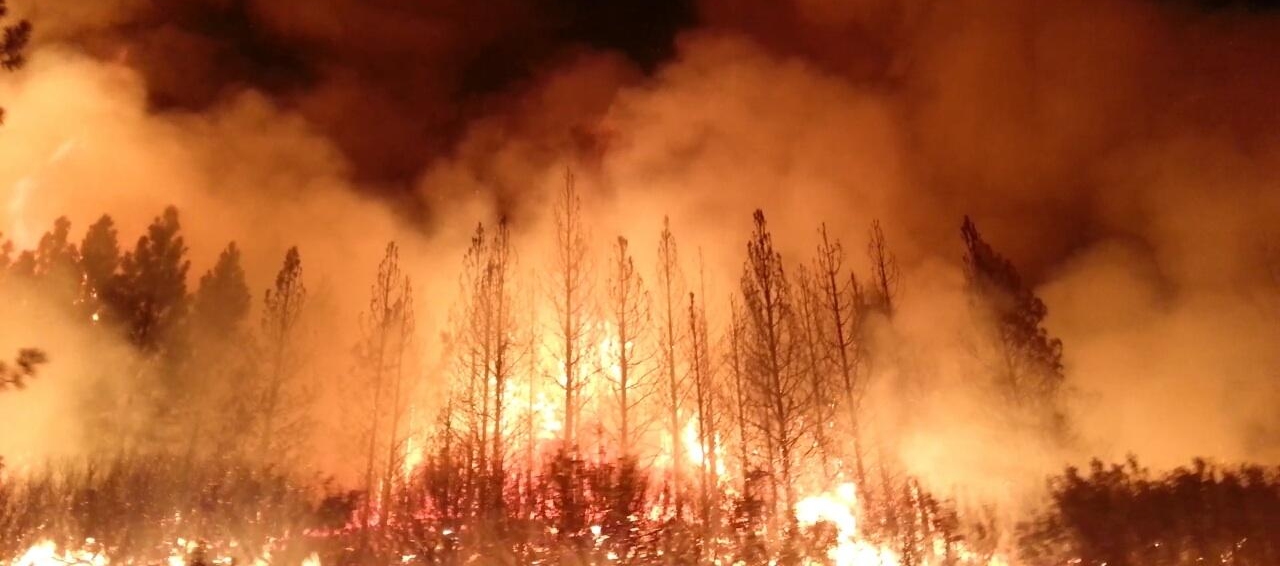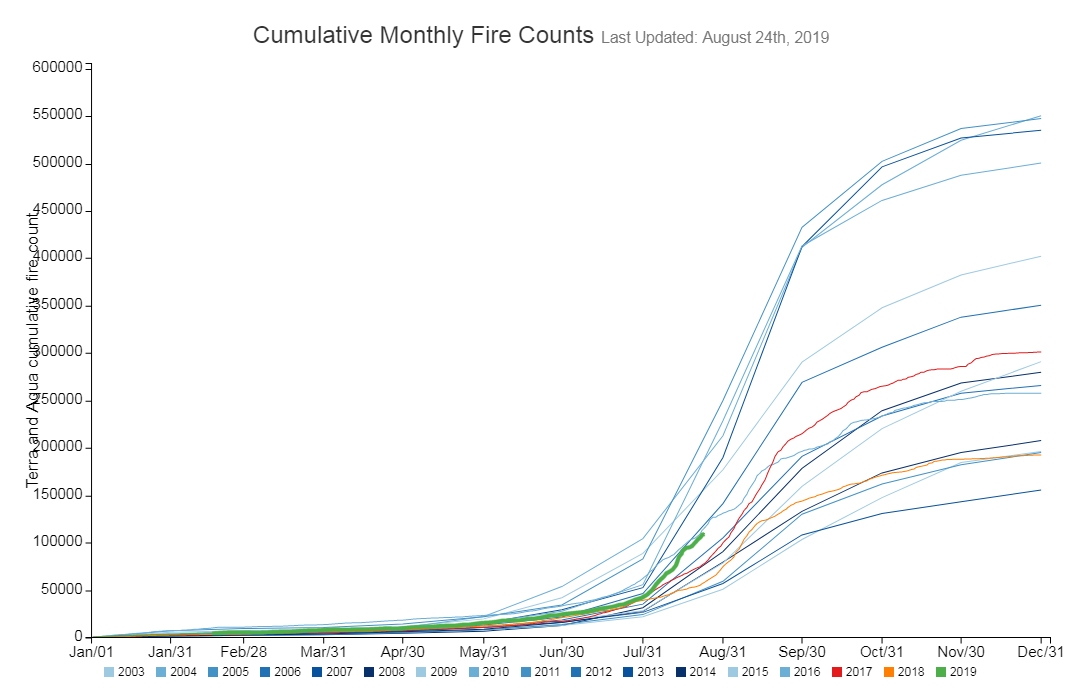
I had another blog post planned for today, but I decided to put it off because over the weekend, I got three questions regarding the fires in the Amazon. People are concerned, mostly because of irresponsible articles like this one:
Brazil’s Amazon rainforest is burning at a record rate, research center says
It’s the classic example of a story that is technically true but absurdly misleading. Indeed, the National Institute for Space Research has never seen the number of forest fires that it is currently seeing in the Amazon. However, as the article notes, that research program started in 2013. So yes, over the past six years, this is the worst year yet. However, if you just broaden your scope a bit, you will see that there is nothing unusual about this year.
While the National Institute for Space Research has only been collecting data about forest fires since 2013, researchers at the Global Fire Emissions Database have been studying them since 2003. That’s almost three times as long. What do their data tell us? Well, all you have to do is go here. It gives you a handy graph that shows you the total count of fires in the Amazon region by year.

To make it stand out, I thickened the green line, which represents this year. As you can see, this year is pretty much dead center compared to the past 16 years. If you go to the link itself, you can put your cursor over the year listed under the graph, and you can see each year clearly. If you do that, you will see that 2003-2007 were all worse than this year, with 2005 setting the record. The data are actually more detailed than this. You can click on areas of the Amazon region on the left part of the website and see data for each region. If you click on “Amazonas,” for example, you will see that a few days in 2019 did set the record in that region.
It’s probably worth noting that many of these fires are caused by people…deliberately. Natural forest fires don’t happen in the Amazon region very often. Most of the fires are being set to clear land for agriculture, and most of them are not in the heavily-forested regions. Also, while you might be worried about deforestation in general, you needn’t be. The latest research indicates the earth has been getting greener since 1982.
UPDATE (08/27/2019): It does seem that there is something unusual happening in the Amazon right now. According to this source:
…the fires were at average levels through to mid August, and then there was a huge uptick.
Why was that? Seems that it started when the farmers in the state of Para declared a “‘dia do fogo,'” or “day of fire” on August 10th. They said they did this in order to show to Bolsonaro that they want to work and that the only way to clear pastures for them to work was with fire (report in Portuguese here), This was spectacularly “successful” and there was an immediate increase in fires which continued through the following weeks.
So there is unusual fire activity right now – more than the standard land-clearing fires for agricultural use. The added fires are the result of political protests.

Wow!
You won’t find this information in the MSM. Thank you for aggregating all of that for us. Very helpful.
On your ‘don’t be worried about deforestation’ point – I take a fair amount of issue. Not with your global data, but with the contextual reality of the situation. I’m from Malawi – and I can guarantee you that deforestation in Malawi is at critical levels, I’ve seen it in my own life time – it’s a level that is clearly visible with the naked eye. Entire mountains have been stripped completely bare and this has led, predictably to mass flooding and avalanches during the rainy seasons. So while your global data is no doubt correct, if you contextualise it – it is important to note that in many, many places globally deforestation is at critical levels.
Overall though, thank you for this alternative perspective. I found it very helpful.
That’s an excellent point. Since I posted this in relation to “global warming,” I was speaking globally. You are quite right that in specific regions, deforestation is a terrible problem.
Regarding the deforestation… I definitely had my eyes opened – at least regarding our redwoods up in Northern California. I stayed at a 400 acre off the grid property near Northspur station (between Fort Bragg and Willits). Our host had mentioned that he purchased the land 50 years ago for a modest sum because it had been completely clear cut by loggers. He was told it would take hundreds of years for reforestation. It seems God had a different plan. Every redwood that was cut sent up a ring trees in its place – right out of the old root system. They call them fairy rings… The old stump in the middle seems to serve as a pulpit for mythical evening merriment. So this gentlemans land is completely reforested. It’s incredible. I do understand that all ecosystems are different and we should be good stewards, but I also think it’s important to remember that God will provide.
Fairy rings are common in mushrooms, but I had never heard about trees forming them. That’s cool.
Thank you, sir, for warning us the pseudoscience eco-terrorists are at it, again, eager to stop hungry people from earning a living. Old-growth produces more CO2 than oxygen. Any forester can tell you that. Young, green, few fungal problems mean carbon sequestering in the soil and trunks of trees. As it is, we know plants need far more CO2 than is available. If they weren’t true, then why do greenhouse operators need to buy dry ice? walk in God’s beauty.
I wouldn’t say plants need more CO2 than what is in the atmosphere. However, most plants will use more CO2 if it is offered. I think greenhouse operators use the extra CO2 to make the plants grow more lush than they otherwise would. We do know that carbon dioxide levels in the atmosphere are rising. That’s a measured fact. Also, estimates are that natural sources (like old-growth forests, animal respiration, etc.) make about 771 billion tons of CO2 per year. Right now, natural sinks (like young forests, dissolving into the ocean, etc.) take in 788 billion tons per year. If that were the end of the story, the CO2 levels would be decreasing. However, industry and land use by people make an additional 29 billion tons per year. So…if we cut our emissions by 60%, the CO2 levels would stay constant, at least for a while.
The issue is not the CO2 itself. It’s what sensitivity does the atmosphere have to extra CO2. That question is yet to be answered.
Strange, the article says:
“The black smoke that turned Sao Paolo, turning daytime almost to night at 2 pm really brought it home to Brazilians.”
We live in the state of Goias. The smoke should’ve passed over us before it hit São Paulo, but it never turned “daytime almost to night” over here.
It’s definitely smokey here, but no more than usual. It’s smokey here every year during the dry season, due to land clearing and random arsonry (hard to tell the one from the other, seems like nobody around here bothers to get a burn permit).
I think it is rather easy for “journalists” to engage in hyperbole when it comes to things like this. After all, how do you confirm or deny such a statement?
I knew the news report on Apple News I read the other day was sensationalized. It claimed the smoke from the fires was so bad that the sky was darkened in daytime in São Paulo. I have done mission in Brazil and flown to São Paulo. It’s on the east coast of Brazil and no where near the Amazon. Serious political misinformation here.